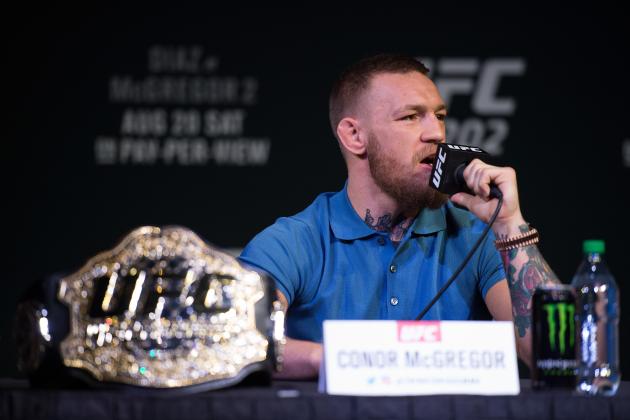The UFC has been a pay-per-view business since its inception, but it has never experienced a stretch of business as successful as it has in the last year. A company that broke the threshold of a million buys on seven occasions before 2015 has now done so five times in the last 10 months.
How?
Conor McGregor.
Of those five pay-per-views, McGregor headlined three. UFC 196 and UFC 202, his two bouts against Nate Diaz, either set or were close to setting the record for buys, the rematch surpassing even the ballyhooed UFC 100 card in 2009 that featured Brock Lesnar and Georges St-Pierre.
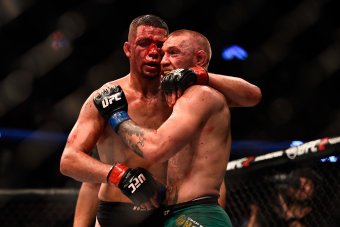
Including his strong performance as the headliner of UFC 189, McGregor has sold a grand total of 5,275,000 pay-per-views in four outings at the top of the card. For comparison, St-Pierre's last six efforts after UFC 100 sold 4,635,000. The four cards Lesnar headlined between 2009 and 2011 had 4,095,000 total buys.
St-Pierre and Lesnar are McGregor's only competitors for this title, and he has blown them out of the water by any reasonable metric.
Buyrates aren't the only measure; gate receipts also point to McGregor's drawing power. Each of the four events McGregor has headlined in Las Vegas produced more gate revenue than any prior show held in the city.
Moreover, McGregor is a fixture on the late-night television circuit and ESPN in a way Lesnar and St-Pierre never were. He's a genuine celebrity. Part-time actor Ronda Rousey, the other head of the UFC's current pay-per-view monster, is even more of a fixture in mainstream entertainment culture, though she hasn't produced quite as much box-office success.
Rousey and McGregor represent the endpoint of a long, ongoing trend in the UFC's pay-per-view business: the ever-increasing importance of star power to sell to the public.
To be clear, star power has always mattered. Fans have historically been more likely to drop their hard-earned money on recognizable fighters than on no-name competitors. With that said, though, the extent to which fans will buy outside the biggest names has varied a great deal in the last eight years.
I examined the buyrate for every pay-per-view dating back to 2005—when the success of The Ultimate Fighter brought the UFC to the fringes of the mainstream—and clear patterns emerged from 2008 to the present. The UFC's pay-per-view business had gone through multiple cycles since then that have led to the current, star-driven state of affairs exemplified by McGregor and Rousey.
Let's start with simple annual sales totals and average buyrates, beginning in 2008:
| Year | Total Pay-Per-View Buys | Number of Events | Average Buyrate |
| 2008 | 6,325,000 | 12 | 527,083 |
| 2009 | 8,020,000 | 13 | 616,923 |
| 2010 | 8,805,000 | 15 | 587,000 |
| 2011 | 6,485,000 | 16 | 405,313 |
| 2012 | 5,835,000 | 13 | 448,846 |
| 2013 | 6,075,000 | 13 | 467,308 |
| 2014 | 3,200,000 | 12 | 266,667 |
| 2015 | 7,550,000 | 13 | 580,769 |
| 2016 | 6,455,000 | 9 | 717,222 |
Outside of 2014, when the pay-per-view side of the UFC's business took a massive nosedive, the total buyrates have been stable over the last nine years.
2009 was an outstanding year, largely driven by the success of the UFC 100 card that set a record with 1.6 million buys, while the UFC sold a staggering 8.805 million units in 2010. 2015 and 2016 (so far) have been outstanding as well. Even without another outing from McGregor or the return of Rousey or St-Pierre, 2016 will surpass 2015's total.
If we're looking at total buys, the period from 2008 to 2013 doesn't show much change: a peak, perhaps an artificial one, but then a return to a stable baseline. When we dig deeper, however, we see a fundamental shift in that period, one that came to fruition in 2014's crisis before the rebound in 2015 and 2016.
Hints of that trend emerge in 2011. By any metric, 2010 was a huge success for the UFC on pay-per-view; its average buyrate was only a touch below that of 2009's record-breaking total despite running more events, and 8.805 million total buys is absurd.
Superficially, 2011 was another strong year, with 6.485 million units sold. It took 16 events to reach that mark, however, and the per-event average was down by roughly 180,000 from 2010. The averages were a bit higher in 2012 and 2013, but were still well below where they had been between 2008 and 2010 despite running strong total sales.
2014's epic disaster—3.2 million units sold at an average of 266,667 per event—the lowest total since 2005—when the UFC sold a paltry 950,000 pay-per-views—was the culmination of the trend that had emerged in the prior few years rather than marking something new.
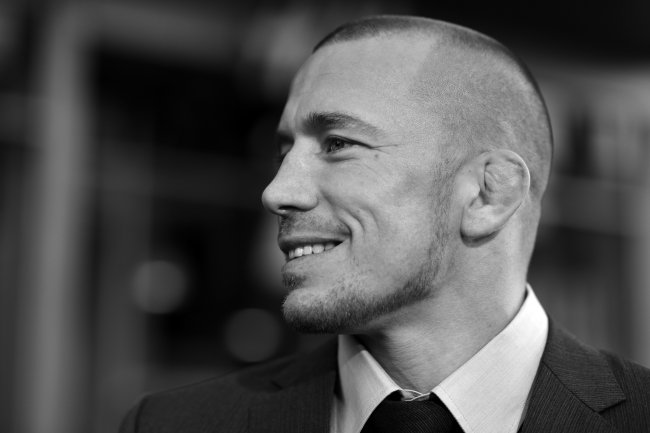
What was that trend? An increasing reliance on a few big names, specifically St-Pierre and Anderson Silva, to sell events.
Let's break that down a bit. Between 2008 and 2011, the UFC was a pay-per-view product. It ran regular events on Spike TV and eventually Versus, but every fight with any name value required the consumer to pay to watch.
Those consumers made up a substantial, loyal audience. The UFC went from UFC 86 to UFC 108 without dropping below 300,000 buys, and by and large, pay-per-view cards were both deep enough on paper and entertaining enough in practice to retain viewer loyalty.
Consider UFC 109 as an example. Injuries gutted the card, which featured a main event of Randy Couture against a shot Mark Coleman, with a then-unknown Chael Sonnen facing Nate Marquardt in the co-main. It still did 275,000 buys.
We might point to the Fox deal, which began in 2012, as the turning point. That is, after all, when the UFC went from being a pay-per-view company that did the occasional TV event to a TV company that did some pay-per-views.
That would be wrong, though. The turning point came in 2011. Why?
Because that's when the UFC oversaturated the pay-per-view market. It did so in a mistaken belief in the inexhaustible power of the UFC brand to sell fights, seemingly operating under the assumption that the fans would buy anything as long as it had those three letters on the marquee. On the contrary, fans rebelled and the brand lost its value as a guarantee of pay-per-view quality.
Moreover, an entire generation of stars such as BJ Penn, Quinton "Rampage" Jackson and even Lesnar moved on into irrelevance in 2011. The fighters who replaced them didn't have their drawing power.
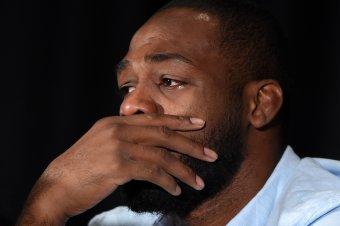
Take Jon Jones. His 2011 was one for the record books as he defeated Ryan Bader in February and took the light heavyweight title from Mauricio Rua in dominating fashion in March. He then defended the belt against Jackson and Lyoto Machida before year's end. It was one of the most impressive runs in the history of the sport, and it should have turned him into a star.
Yet none of that turned Jones into a big-time draw. He sold right around what previous light heavyweight title fights had done—500,000 buys—despite the fact that a well-promoted fight between Jackson and Rashad Evans had broken a million buys the year before. Even now, Jones has never gotten over the hump.
Or look at Frankie Edgar, who replaced Penn as the lightweight champion. Edgar's two headlining efforts in 2011 drew just 260,000 and 225,000 buys, while Penn had drawn 620,000, 850,000 and 920,000 in his three prior outings on pay-per-view. Meanwhile, the two losses to Edgar damaged Penn as a draw, and his two headliners in 2011 drew just 260,000 and 280,000 buys.
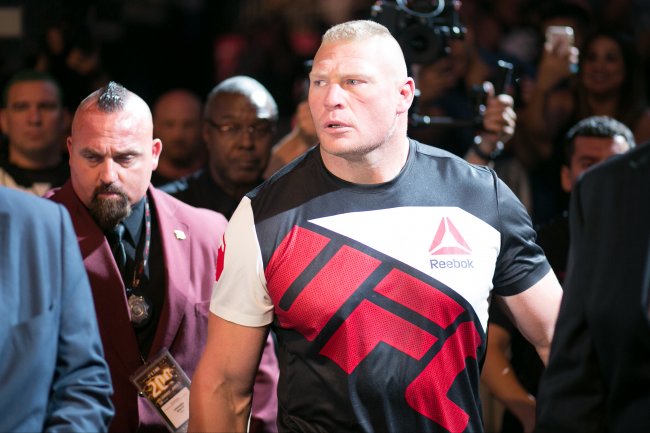
The same thing happened at heavyweight. Cain Velasquez brutalized Lesnar to win the title in October 2010, but Velasquez fell to Junior Dos Santos by knockout in his first title defense (on Fox, not pay-per-view) the next year. Neither Velasquez nor Dos Santos ever approached Lesnar's substantial drawing power. Lesnar's last headlining fight in 2011 drew only 535,000 buys, barely half of what he'd notched in his two prior bouts.
So the UFC put on too many pay-per-view cards—many of which were subpar in quality compared to the heyday of 2008-10—at the same time as its big draws were getting old and the replacements weren't as compelling to the audience.
The baseline drawing power of the UFC brand fell.
Between 2011 and 2013, the average buyrate per event dropped substantially, but it was always above 400,000. This average concealed the fact that only Silva and St-Pierre were the only fighters consistently drawing at a high rate.
| Year | Silva and St-Pierre Average (Percent of Year's Total) | All Other Headliners Average |
| 2011 | 620,000 (29 percent, three events) | 355,769 |
| 2012 | 678,333 (35 percent, three events) | 380,000 |
| 2013 | 788,750 (52 percent, four events) | 324,444 |
| Three-Year Average | 705,000 (10 events) | 354,531 |
During that three-year stretch, Silva and St-Pierre headlined 10 events (six for Silva, four for St-Pierre). The two combined to average 705,000 buys per event, including the only event, UFC 168, to do more than a million buys between 2011 and 2013. Events not headlined by those two drew just over half their average at 354,531.
That trend reached its most striking level in 2013, when Silva and St-Pierre combined to sell a staggering 3,155,000 pay-per-views, 52 percent of the year's total.
The two stars' herculean efforts disguised just how weak the UFC brand had become on pay-per-view. Multiple cards, two each in 2012 and 2013, failed to break the 200,000-buy mark. That hadn't happened since 2005, when Andrei Arlovski and Paul Buentello headlined UFC 55.
Essentially, hundreds of thousands of formerly reliable pay-per-view buyers had left the UFC's market during that three-year stretch. They might have shown up for the biggest names, but they no longer found it necessary to buy every card, or even most of them.
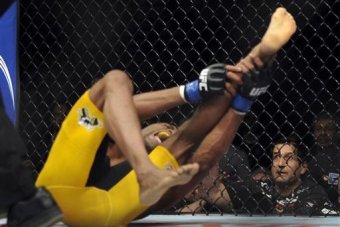
And what happened in 2014? Silva was injured the entire year and St-Pierre had retired. Without its two biggest stars, the UFC's pay-per-view business collapsed.
UFC 175, which featured both Chris Weidman and Ronda Rousey, did 545,000 buys. No other event did more than 350,000. Four cards failed to crack 200,000 buys. The abysmal UFC 174 and UFC 177 cards, the latter of which lost one of its main event fighters in a weight-cutting mishap, did 115,000 and 125,000 buys respectively.
Aside from the fact that Silva and St-Pierre were out of action, even normally reliable draws seemed to have lost their ability to part viewers from their money. Jones drew just 350,000 buys against Glover Teixeira at UFC 172, on the heels of only 310,000 against Alexander Gustafsson in September 2013.
There's no sugarcoating it: 2014 was a disaster, but it was a calamity whose roots had been percolating for a while.
Even comparing the year's average of 266,667 buys to the 2011-2013 averages without Silva and St-Pierre, nearly 100,000 formerly reliable pay-per-view customers stopped buying events, further damaging the brand that had already taken serious hits after its peak between 2008 and 2010.
So what happened in 2015 and 2016 to turn things around? McGregor and Rousey, especially the former.

Let's crunch the numbers. McGregor has sold 5,275,000 pay-per-views in the last two years, while Rousey sold 2,600,000 in her three headlining efforts in 2015. That's 56 percent of the total, accounting for seven of 22 events with an average of 1,125,000 per event. Other headliners averaged 408,667 buys in 2015 and 2016.
The UFC's reliance on its biggest stars to sell the lion's share of pay-per-views hasn't changed. The average buyrate has ticked up from the cards not headlined by Silva or St-Pierre between 2011 and 2013, as well as from 2014's dismal showing, but it's not drastically higher.
Moreover, 2015 benefited from the well-promoted grudge match between Daniel Cormier and Jones, an outlier for both fighters' average drawing power, and 2016's outstanding UFC 200 card drew its 1,200,000 estimated buys from its unmatched depth—the main card featured seven current or former champions—and Lesnar's return.
In sum, despite its success with McGregor and to a lesser extent Rousey, the UFC hasn't replicated the consumer faith in its baseline pay-per-view product that led to such a high average buyrate in its heyday between 2008 and 2010.
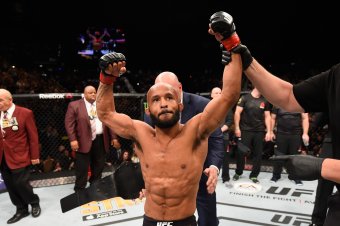
For example, two cards headlined by Demetrious Johnson in 2015 drew 115,000 and 125,000 buys. A stacked UFC 192 card featuring light heavyweight champion Cormier and former champion Rashad Evans drew a paltry 250,000 buys. In 2016, the UFC 199 card featuring a pair of title fights sold just 320,000 units, and the stacked UFC 198 card before it pulled under 300,000.
The UFC's pay-per-view business is doing bigger numbers in the aggregate than it has since its heyday, but that success is largely the result of McGregor's drawing power. Rousey, too, was a central component of that, and unless the loss to Holly Holm ruined her as a star, she is another piece of the UFC's foundation on pay TV.
What does all of this mean?
McGregor represents the culmination of the UFC's reliance on its stars. The audience that will pay for anything is tiny—hundreds of thousands of buyers smaller than it was back between 2008 and 2010.
If McGregor retires young, something he has mentioned several times, and Rousey never returns, the promotion will be only slightly better off than it was during its 2014 doldrums. While it derives income from a vast array of sources, including Fight Pass and its U.S. and international TV deals, the structural issues of the UFC's pay-per-view business haven't changed despite its recent success.
The emergence of transcendent stars hasn't solved those fundamental problems; it has merely disguised them.
All pay-per-view buyrate numbers are sourced by Dave Meltzer of Wrestling Observer Newsletter and then compiled by MMA Payout and/or posted on MMA Fighting by Meltzer himself. These numbers are estimates, and real figures, which are almost never reported, may vary by as much as 30 percent in either direction. For this article, however, what matters is that the methodology for the estimates is internally consistent. Gate revenue is released after each event by the state athletic commission.
Patrick Wyman is the Senior MMA Analyst for Bleacher Report and the co-host of the Heavy Hands Podcast, your source for the finer points of face-punching. For the history enthusiasts out there, he also hosts The Fall of Rome Podcast on the end of the Roman Empire. He can be found on Twitter and on Facebook.
